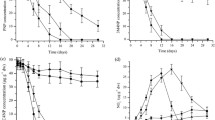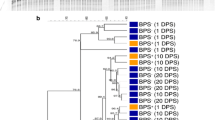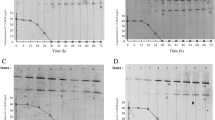Abstract
The capacity of the β-Proteobacterium Pseudomonas sp. strain P51, which degrades chlorinated benzenes, to metabolize 1,2,4-trichlorobenzene (TCB) under environmental conditions was tested by its release into two experimental systems. The first system consisted of laboratory scale microcosms which were operated with and without the addition of TCB and which were inoculated with sludge from a wastewater treatment plant. The second system consisted of a non sterile, water saturated soil column. We determined survival of strain P51 after its introduction and its ability to degrade TCB. The population dynamics was followed by selective plating and applying the polymerase chain reaction (PCR) to detect strain P51 and the chlorobenzene ( tcb) genes on catabolic plasmid pP51. The results showed a completely different behaviour of strain P51 in the two habitats under the applied conditions. In the soil column the P51 bacteria inoculated the entire area and their population reached 2 × 106 cells/g soil. The population remained active since TCB was degraded to concentrations below the detection limit of 30 μg/l. In the sludge microcosms, the number of strain P51 cells immediately decreased from 4 × 107 cells/ml to 105 cells/ml over a period of 2 days after inoculation, and then the strain disappeared to levels below our detection limit (103–104 cells/ml). In the reactor without TCB the population of P51 maintained a stable value of 105 cells/ml during 8 days but then also decreased to levels below the detection limit. In addition, no significant TCB degradation was found in the sludge reactors. The influence of presence of TCB on maintenance of strain P51 in the two habitats is discussed. This work demonstrates the possibility to successfully apply preselected strains to degrade otherwise poorly degradable substances in complex mixed microbial communities. However, survival and activity may depend strongly on the type of system into which the strain is introduced.
Similar content being viewed by others
References
Arturo SM, Tamanai SZ, Thomas D & Cormier M (1996) Variations in R-plasmid DNA concentrations of Escherichia coli during starvation in sewage and brackish waters. J. Appl. Bacteriol. 80: 117–123
Blasco R, Wittich RM, Mallavarapu M, Timmis KN & Pieper DH (1995) From xenobiotic to antibiotic, formation of protoanemonin from 4-chlorocatechol by enzymes of the 3-oxoadipate pathway. J. Biol. Chem. 270: 29229–29235
Brunsbach FR & Reineke W (1993) Degradation of chlorobenzoates in soil slurry by special organisms. Appl. Microbiol. Biotechnol. 39: 117–122
Egli T (1995) The ecological and physiological significance of the growth of heterotrophic microorganisms with mixtures of substrates. Adv. Microb. Ecol. 14: 305–386
El Fantroussi S, Mahillon J, Naveau H & Agathos SN (1997) Introduction and PCR detection of Desulfomonile tiedjei in soil slurry microcosms. Biodegradation 8: 125–133
Felsenstein J. 1993. PHYLIP: phylogeny inference package. Department of Genetics, University of Washington, Seattle
Fujita M, Ike M & Hashimoto S (1991) Feasibility of wastewater treatment using genetically engineered microorganisms. Wat. Res. 25: 979–984
Goldstein RM, Mallory LM & Alexander M (1985) Reasons for possible failure of inoculation to enhance biodegradation. Appl. Environ. Microbiol. 50: 977–983
Hallier-Soulier S, Ducrocq V, Mazure N & Truffaut N (1996) Detection and quantification of degradative genes in soils contaminated by toluene. FEMS Microbiol. Ecol. 20: 121–133
Jansson JK (1995) Tracking genetically engineered microorganisms in nature. Curr. Opin. Biotechnol. 6: 275–283
Kumar PK & Schugerl K (1990) Immobilization of genetically engineered cells: a new strategy for higher stability. J. Biotechnol. 14: 255–272
Leser TD, Boye M & Hendriksen NB (1995) Survival and activity of Pseudomonas sp. strain B13(FR1) in a marine microcosm determined by quantitative PCR and an rRNA-targeting probe and its effect on the indigenous bacterioplankton. Appl. Environ. Microbiol. 61: 1201–1207
Lévesque M-J, S. LB, Thomas J-C, Beaudet R & Villemur R (1997) Rapid method for detecting Desulfitobacterium frappieri strain PCP-1 in soil by the polymerase chain reaction. Appl. Microbiol. Biotechnol. 47: 719–725
Maidak BL, Olsen GJ, Larsen N, Overbeek R, McCaughey MJ & Woese CR (1996) The ribosomal database project (RDP). Nucl. Acids Res. 24: 82–85
McClure NC, Fry JC & Weightman AJ (1991) Survival and catabolic activity of natural and genetically engineered bacteria in a laboratory-scale activated-sludge unit. Appl. Environ. Microbiol. 57: 366–373
McClure NC, Weightman AJ & Fry JC (1989) Survival of Pseudomonas putida UWC1 containing cloned catabolic genes in a model activated-sludge unit. Appl. Environ. Microbiol. 55: 2627–2634
Megharaj M, Wittich R-M, Blasco R, Pieper DH & Timmis KN (1997) Superior survival and degradation of dibenzo-p-dioxin and dibenzofuran in soil by soil-adapted Sphingomonas sp. strain RW1. Appl. Microbiol. Biotechnol. 48: 109–114
Pearson DJ & Lipman WR (1988) Improved tools for biological sequence analysis. Proc. Natl. Acad. Sci. USA 85: 2444–2448
Pipke R, Wagner-Döbler I, Timmis KN & Dwyer DF (1992) Survival and function of a genetically engineered Pseudomonad in aquatic sediment microcosms. Appl. Environ. Microbiol. 58: 1259–1265
Postma J & van Veen JA (1990) Habitable pore space and population dynamics of Rhizobium leguminosarum biovar trifolii introduced into soil. Microb. Ecol. 19: 149–161
Proctor GN (1994) Mathematics of microbial plasmid instability and subsequent differential growth of plasmid-free and plasmid-containing cells, relevant to the analysis of experimental colony number data. Plasmid 32: 101–130
Ravatn R, Zehnder AJB & Van der Meer JR (1998) Low-frequency horizontal transfer of an element containing the chlorocatechol degradation genes from Pseudomonas sp. strain B13 to Pseudomonas putida F1 and to indigenous bacteria in laboratory-scale activated-sludge microcosms. Appl. Environ. Microbiol. 64: 000–000
Recorbet G, Picard C, Normand P & Simonet P (1993) Kinetics of the persistence of chromosomal DNA from genetically engineered Escherichia coli introduced into soil. Appl. Environ. Microbiol. 59: 4289–4294
Sachs L (1984) Angewandte Statistik. Springer, Berlin
Sambrook J, Fritsch EF & Maniatis T (1989) Molecular cloning: a laboratory manual. Cold Spring Harbor Laboratory, Cold Spring Harbor, NY
Selvaratnam S, Schoedel BA, McFarland BL & Kulpa CF (1997) Application of the polymerase chain reaction (PCR) and reverse transcriptase/PCR for determining the fate of phenol-degrading Pseudomonas putida ATCC 11172 in a bioaugmented sequencing batch reactor. Appl. Microbiol. Biotechnol. 47: 236–240
Snaidr J, Amann R, Huber I, Ludwig W & Schleifer K-H (1997) Phylogenetic analysis and in situ identification of bacteria in activated sludge. Appl. Environ. Microbiol. 63: 2884–2896
Sobecky PA, Schell MA, Moran MA & Hodson RE (1992) Adaptation of model genetically engineered microorganisms to lake water: growth rate enhancements and plasmid loss. Appl. Environ. Microbiol. 58: 3630–3637
Sykes PJ, Neoh SH, Brisco MJ, Hughes E, Condon J & Morley AA (1992) Quantitation of targets for PCR by use of limiting dilution. Biotechniques 13: 444–449
Van der Meer JR, Eggen RIL, Zehnder AJB & de Vos WM (1991a) Sequence analysis of the Pseudomonas sp. strain P51 tcb gene cluster, which encodes metabolism of chlorinated catechols: evidence for specialization of catechol 1,2-dioxygenases for chlorinated substrates. J. Bacteriol. 173: 2425–2434
Van der Meer JR, Frijters ACJ, Leveau JHJ, Eggen RIL, Zehnder AJB & de Vos WM (1991b) Characterization of the Pseudomonas sp. strain P51 gene tcbR, a LysR-type transcriptional activator of the tcbCDEF chlorocatechol oxidative operon, and analysis of the regulatory region. J. Bacteriol. 173: 3700–3708
Van der Meer JR, Roelofsen W, Schraa G & Zehnder AJB (1987) Degradation of low concentrations of dichlorobenzenes and 1,2,4-trichlorobenzene by Pseudomonas sp. strain P51 in non-sterile soil columns. FEMS Microbiol. Ecol. 45: 333–341
Van der Meer JR, Werlen C, Nishino SF & Spain JC (1998) Evolution of a pathway for chlorobenzene metabolism leads to natural attenuation in contaminated groundwater. Appl. Environ. Microbiol. 64: 4185–4193
Wagner DI, Pipke R, Timmis KN & Dwyer DF (1992) Evaluation of aquatic sediment microcosms and their use in assessing possible effects of introduced microorganisms on ecosystem parameters. Appl. Environ. Microbiol. 58: 1249–1258
Watanabe K, Yamamoto S, Hino S & Harayama S (1998) Population dynamics of phenol-degrading bacteria in activated sludge determined by gyrB-targeted quantitative PCR. Appl. Environ. Microbiol. 64: 1203–1209
Weisburg WG, Barns SM, Pelletier DA & Lane DJ (1991) 16S ribosomal DNA amplification for phylogenetic study. J. Bacteriol. 173: 697–703
Werlen C, Kohler H-PE & Van der Meer JR (1996) The broad substrate chlorobenzene dioxygenase and cis-chlorobenzene dihydrodiol dehydrogenase of Pseudomonas sp. strain P51 are linked evolutionarily to the enzymes for benzene and toluene degradation. J. Biol. Chem. 271: 4009–4016
Rights and permissions
About this article
Cite this article
Tchelet, R., Meckenstock, R., Steinle, P. et al. Population dynamics of an introduced bacterium degrading chlorinated benzenes in a soil column and in sewage sludge. Biodegradation 10, 113–125 (1999). https://doi.org/10.1023/A:1008368006917
Issue Date:
DOI: https://doi.org/10.1023/A:1008368006917




